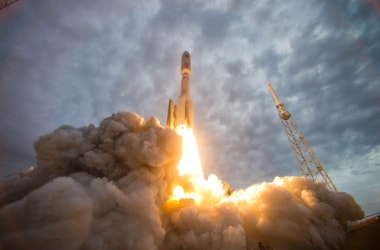
Indian Space Research Organisation (ISRO) created history by successfully launching a record 104 satellites in single mission.
These satellites were launched on board of Polar Satellite Launch Vehicle PSLV-C37, on its 39th mission from Satish Dhawan Space Centre, Sriharikota, Andhra Pradesh.
Of the total 104 satellites, three were Indian and remaining 101 belonged to international customers.
India’s three satellites included earth-mapping Cartosat-2 satellite (main payload) and nano satellites INS-1A and INS-1B.
Of the 101 co-passenger satellites, 96 belong to US and remaining 5 from Israel, Kazakhstan, Netherlands, Switzerland, United Arab Emirates, respectively.
Around 90 small satellites belonged to US-based company Planet Inc.
They are named ‘Doves’ and their constellation will be used to image the earth at low cost.
In this mission, PSLV first launched the Cartosat-2 and then its 103 co-passengers (together weighing about 664 kg) into the polar Sun Synchronous Orbit (SSO), about 520 km from the Earth.
This mission beat the previous record held by Russia, which in 2014 had catapulted 37 satellites in a single launch, using a modified inter-continental ballistic missile.
It also broke ISRO’s previous national record set in June 2016, after it had successfully launched 20
The total weight of all the 104 satellites carried on-board PSLV-C37 was 1378 kg.
The total number of Indian satellites launched by PSLV now stands at 46.
Of the 103 co-passenger satellites carried by PSLV-C37, two - ISRO Nano Satellite-1 (INS-1) weighing 8.4 kg and INS-2 weighing 9.7 kg - are technology demonstration satellites from India.
The remaining 101 co-passenger satellites carried were international customer satellites from USA (96), The Netherlands (1), Switzerland (1), Israel (1), Kazakhstan (1) and UAE (1).
This mission involved many technical challenges like realising the launch of a large number of satellites during a single mission within the time frame sought by the customers from abroad.
Besides, ensuring adequate separation between all the 104 satellites during their orbital injection as well as during their subsequent orbital life was yet another challenge associated with this complex mission.
With today’s successful launch, the total number of customer satellites from abroad launched by India’s workhorse launch vehicle PSLV has reached 180.
Cartosat-2 Satellite: Know More- It was the primary payload of the mission.
- It is similar to the earlier four satellites in Cartosat-2 Series.
- It weighs 714 kg and has a mission life of five years.
- It is earth observation satellite that will provide remote sensing services.
- Images sent by it will be useful for coastal land use and regulation, road network monitoring and creation of land use maps.
- The imagery from the Cartosat-2 series satellite will be useful for: cartographic applications, urban and rural applications, coastal land use and regulation, utility management like road network monitoring, water distribution.
- It will also aid creation of land use maps, change detection to bring out geographical and manmade features and various other Land Information System (LIS) and Geographical Information System (GIS) applications.
- The data sets could be used for urban planning of 500 cities under the Amrut Planning Scheme.
- The government initiative of 100 smart city programme in which these data sets could be used for master plan preparation and detailed geospatial data preparation for rural roads and infrastructure development.
INS-1A and INS-1B Satellites
- They are nano satellites.
- INS-1A was carrying Surface Bidirectional Reflectance Distribution Function Radiometer.
- INS-1B was carrying Earth Exosphere Lyman Alpha Analyser as payloads.
Launch Vehicle:
- For this mission, ISRO had used XL Variant of PSLV rocket standing 44.4 metres tall and weighing 320 tonnes.
It is most powerful rocket of ISRO and earlier was used in launching ambitious Chandrayaan and Mars Orbiter Mission (MOM).